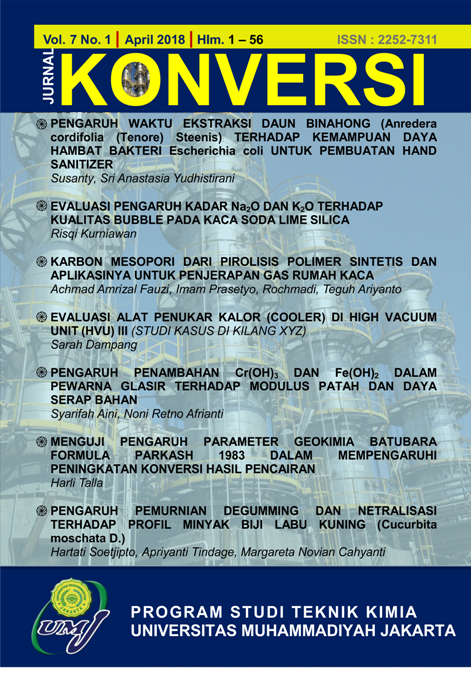KARBON MESOPORI DARI PIROLISIS POLIMER SINTETIS DAN APLIKASINYA UNTUK PENJERAPAN GAS RUMAH KACA
Main Article Content
Abstract
Pore structures are needed to be tuned depending on utilizations of carbons, hence obtaining high application performances. In this work, mesoporous carbon was synthesized by pyrolysis of polymeric resin of resorcinol-phenol-formaldehyde-ethylene glycol (RPFEG) and employed to adsorb a greenhouse gas of CO2. Carbons were produced at 650-775 oC pyrolysis temperatures. Pore structure was studied by N2-sorption analysis. The results showed that a high quality of carbon results, proven by high specific surface areas and pore volumes in the range of 1000-1300 m2/g and 0,6-1,4 cm3/g, respectively. Mesoporous carbon (>80% mesopores) was obtained when employing pyrolysis temperature of 750 oC. Isotherm curves showed that adsorption at lower temperature is appropriate to obtain a high adsorption capacity. Capillary condensation assisted to obtain high adsorption volume of CO2 up to 30 mmol/g at 25 °C and 30 bar pressure.
Article Details
Issue
Section
Articles
Authors who publish with this journal agree to the following terms:
- Authors retain copyright and grant the journal right of first publication with the work simultaneously licensed under a Creative Commons Attribution License that allows others to share the work with an acknowledgement of the work's authorship and initial publication in this journal.
- Authors are able to enter into separate, additional contractual arrangements for the non-exclusive distribution of the journal's published version of the work (e.g., post it to an institutional repository or publish it in a book), with an acknowledgement of its initial publication in this journal.
- Authors are permitted and encouraged to post their work online (e.g., in institutional repositories or on their website) prior to and during the submission process, as it can lead to productive exchanges, as well as earlier and greater citation of published work (See The Effect of Open Access).
